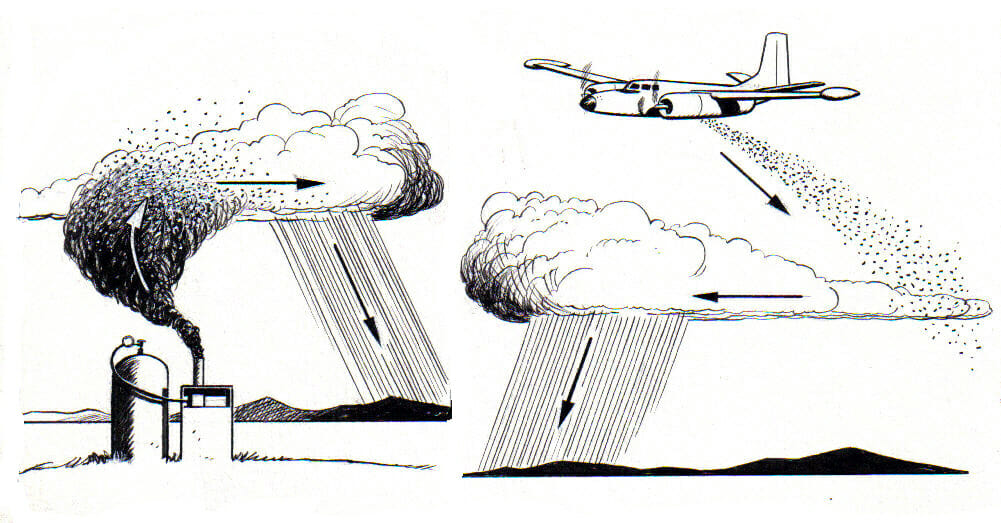The Chinese government successfully controlled the weather ahead of a major political celebration earlier this year, a study by Tsinghua University reveals.
On July 1, the Chinese Communist Party marked its 100th anniversary which saw a rally of over 700,000 people at Tiananmen square, it was grandiose for its military-flyover and 100-gun salute. The occasion was also marked by an elaborate cloud-seeding program in the hours preceding the event in order to ensure clear-blue skies over Beijing throughout the ceremony.
A recent report from the South China Morning Post confirms the operation succeeded in ensuring the decimation of clouds and to pave the way for a clear blue sky. Thanks to cloud-seeding technology, the city saw a significant drop in air pollution, with air pollutants reduced by two-thirds. This shifted the air quality index reading from “moderate” to “good” under the World Health Organisation standards.
This is, of course, not the first time that China has experimented with cloud-seeding technology to manipulate weather conditions, which has been used ever-since the 2008 summer Olympic Games.
Cloud seeding is a type of weather modification that aims to change the amount of precipitation that falls from clouds by dispersing chemicals – notably silver iodide – into the air. When these substances are introduced, the water droplets cluster together, increasing the likelihood of rainfalls. This has the aftermath effect of reducing clouds enabling the ability to obtain clear blue skies almost on demand.

Whilst this sort of technology is considered to mitigate the effects of global warming by directly cooling the planet down, or by forcing rain onto droughts-affected areas, the negative consequences on ecosystems and biodiversity are still largely unknown.
The operation did cause inconvenience to nearby residents in the mountains to the southwest of the city. On June 30, the eve of the centenary, residents were affected by the noise and saw a large number of rockets sent into the sky.
“It was very loud, like thunder – and it went on for a very, very long time…it was like a war zone,” one resident told the South China Morning Post. “Then the rain came down, it was quite heavy”
Another man said he found debris from the rockets outside his home, according to the same report. The negative consequences of cloud-seeding begin on the on-set of operations with high noise and light pollution, potential of floodings, as well as waste from the rockets in nearby locations. Before observing the broader implications of this process, we may well wonder whether it’s all worth it.
Cloud-seeding engineering is more widespread than we think
Proponents of cloud-seeding believe that this process could increase precipitation and alleviate the effects of climate change by resorting to human agency to induce rainfalls over areas experiencing widespread droughts.
Last year, China revealed plans to drastically expand its weather modification program to cover an area of over 5.5 million square kilometre – more than 1.5 times the size of India. In the next five years, the program will help with disaster relief, agriculture production, emergency responses to forest and grassland fires, and dealing with usually high temperatures or droughts.
Although the research on the potential consequences of controlling the weather is still inconclusive, the Communist Party has invested massively in the practice. Between 2012 and 2017, it has spent over $1.34 billion on various weather modification programs.
But China is not alone. The practice of cloud-seeding has been around since the 1940s, and more than 50 countries, notably the US and the UAE, have experimented with the practice. As climate change has worsened in recent years, and natural disasters have increased in frequency and severity, the practice has taken on renewed popularity.
Critics argue geoengineering provides a negative incentive of allowing the wealthiest people in developed countries to continue business-as-usual. What makes this sort of technology so attractive is the idea that if used widely, we could avoid having to change behavioural patterns whilst still reaching Paris Agreements goals and keeping the planet heat below 1.5 degrees.
“The appeal is easy to understand. Geoengineering offers the tantalising promise of a climate change fix that would allow us to continue our resource-exhausting way of life, indefinitely” – says Naomi Klein in her recent book On Fire.
This is, of course, an illusion.
But where’s the catch? The environmental and social cost of controlling the weather

At first-glance cloud-seeding and other types of geoengineering processes appear to be the greatest solution humans have ever found to solve climate change and global warming. Until we remind ourselves that solving human-induced climate change with human-induced weather modification processes could have a catch.
Silver iodide, for example, is potentially harmful for the natural environment and may intoxicate food supply chains. The artificial rain induced by cloud-seeding is contaminated with the chemical, intoxicating the plants that rely on this rain, which can then go on to contaminate the animals who feed off them.
Whilst the toxicity of silver and silver compounds has shown to be low, the accumulation of the chemical over time in the soil, and vegetation have not been large enough to arrive at significant conclusions.
The fact that the long-term environmental consequences of such practices are still unknown, and that they were not determined prior to the relatively widespread use of the practice, is worrying.
Related Articles: The Science and Politics of Geoengineering: A Fast Solution to an Intricate Problem | The Use of Gene Editing to Adapt to the Climate Crisis
In 2017, the ETC Group, the Heinrich Böll Foundation, and Biofuelwatch produced a report on geoengineering called “The Big Bad Fix.” The report demonstrated how each geoengineering process effectively “threatens people and ecosystems” and if deployed at a large-scale is “likely to worsen rather than mitigate the impacts of global warming.”
The use of this technology is likely to exacerbate climate change and global warming as a result of human-interference in the natural cycle of the environment, which will impact climate-vulnerable nations even more greatly.
Furthermore, geoengineering processes, particularly cloud-seeding, if not controlled and regulated could be used as weapons of war. Diplomatic ties between India and China have been severed as the latter has expanded on its weather modification program. India has speculated that weather modification could give China the edge in future conflict over its much-contested border in the Himalayas, given the importance of conditions to any troop movements in the mountainous region.
Although the primary focus of geoengineering is domestic, experts have warned there is the potential for the impact to be beyond the country’s borders.
“Without regulation, one country’s efforts could affect other countries,” says Dhanasree Jayaram, a climate expert at the Manipal Academy of Higher Education in Karnataka, India.
The report concludes that geoengineering is “an unacceptable option,” it is simply not the right answer to the issue of climate change and global warming.
As Naomi Klein rightly questions, “Wouldn’t it be better to change our behaviour, to reduce our use of fossil fuels, before we begin fiddling with the planet’s basic life-support system?”
Editor’s Note: The opinions expressed here by Impakter.com columnists are their own, not those of Impakter.com. — In the Featured Photo: Official logo of the 100th Anniversary of the Communist Party of China, displayed in front of Changsha Ecological Zoo, in Changsha, Hunan, China. Featured Photo Credit: Wikimedia Commons.









